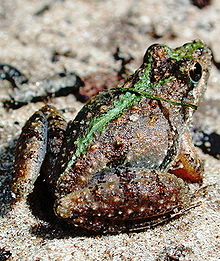| Cricket frogs | |
|---|---|

| |
| Acris gryllus | |
| Scientific classification | |
| Domain: | Eukaryota |
| Kingdom: | Animalia |
| Phylum: | Chordata |
| Class: | Amphibia |
| Order: | Anura |
| Family: | Hylidae |
| Subfamily: | Acrisinae |
| Genus: | Acris Duméril & Bibron, 1841 |
| Species | |
Cricket frogs, genus Acris, are small, North American frogs of the family Hylidae.[1][2] They occur in northern Mexico (Coahuila), the United States east of the Rocky Mountains, and in southern Ontario, Canada.[1]
They are more aquatic than other members of the family, and are generally associated with permanent bodies of water with surface vegetation. This is a quite important aspect of their survival, as adult cricket frogs suffer high mortality rates when submerged in poorly oxygenated water (typically less than 24 hours on average in water that is ~1.2 mg/L).[3] The common and scientific names refer to their call, which resembles that of a cricket. The two common species are A. crepitans and A. gryllus. A. crepitans are found in mesic woodlands as well as xeric grasslands, whereas A. gryllus are concentrated in mesic woodlands.
Cricket frogs are able to communicate and attract each other using a specific frequency of their mating call, that sounds like a cricket. It can only be heard by members of the same population. Cricket frogs from other locales are unable to aurally process other calls, leading to mating isolation among the species.[4]
- ^ a b c Cite error: The named reference
Frostwas invoked but never defined (see the help page). - ^ Cite error: The named reference
AmphibiaWebwas invoked but never defined (see the help page). - ^ Hoskins, Tyler D.; Dellapina, Maria; Papoulias, Diana M.; Boone, Michelle D. (2019-04-01). "Effects of larval atrazine exposure in mesocosms on Blanchard's cricket frogs (Acris blanchardi) reared through overwintering and to reproductive age". Chemosphere. 220: 845–857. Bibcode:2019Chmsp.220..845H. doi:10.1016/j.chemosphere.2018.12.112. ISSN 0045-6535. PMID 33395806. S2CID 104305772.
- ^ Ryan, Michael J. (1988-06-24). "Coevolution of sender and receiver: Effect on local mate preferecnce in Cricket Frogs". Science. 240 (4860): 1786. Bibcode:1988Sci...240.1786R. doi:10.1126/science.240.4860.1786. ISSN 0036-8075. PMID 17842431. S2CID 27475731.